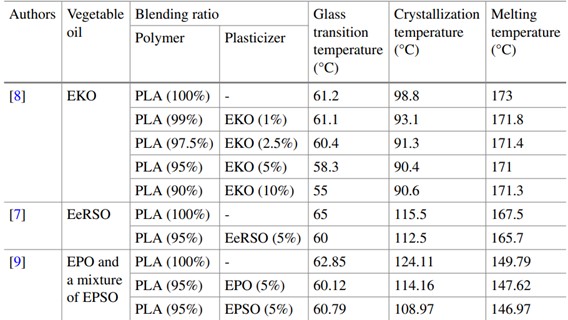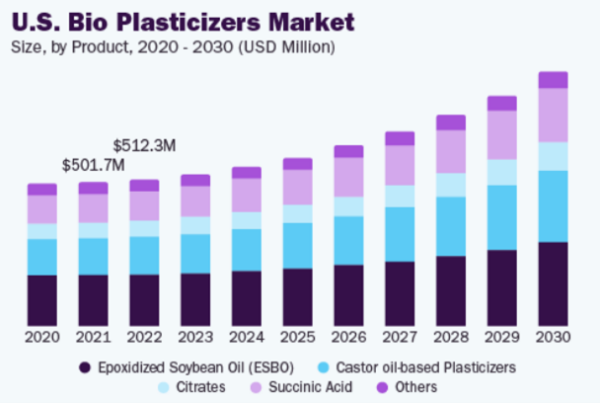Bio-Based Plasticizers: a Sustainable Approach to Enhance PLA Performance

Polylactic Acid (PLA) has gained popularity as a sustainable alternative to traditional fossil-based thermoplastics such as polyethylene terephthalate (PET) and polystyrene (PS).
The renewability and biodegradable properties of PLA make it a desirable option for a variety of uses, including food packaging, biomaterial healthcare, and 3D printing filament. However, PLA’s poor ductility, low toughness, and unsuitable thermal properties have limited its use in flexible packaging. Researchers have focused on improving PLA’s properties by adding bio-based plasticizers to address these constraints.
You can also read: From Plastic to Wax: A Technology for Biodegradability
Human Health Aspects of Plasticizers
In addition, traditional phthalates have raised health concerns since high amounts of DEHP in animal diets cause liver tumors. Consequently, the International Agency for Research on Cancer (IARC) classified it as “probably carcinogenic to humans”.
The ongoing disputes about the health effects of phthalates highlight the importance of looking into safer alternatives. For this reason, Bio-based plasticizers derived from vegetable oils emerge as sustainable options for improving polymers such as PLA without compromising health and the environment. Regulations on phthalates in toys underscore the growing acknowledgment of risks linked to conventional plasticizers.
Types of Bio-Based Plasticizers
A recent study by the Universiti Teknikal Malaysia Melaka investigated various bio-based plasticizers generated from vegetable oils, including Epoxidized Karanja Oil (EKO), Epoxidized Rubber Seed Oil (EeRSO), Epoxidized Palm Oil (EPO), and a mixture of Epoxidized Palm Oil and Soybean Oil (EPSO).
Enhancing Thermal Properties
The addition of bio-based plasticizers has a significant impact on PLA’s thermal properties, including the glass transition temperature (Tg), crystallization temperature (Tcc), and melting temperature (Tm). Researchers have observed a decrease in these temperatures with increasing plasticizer content, indicating improved flexibility and processability of PLA blends.

Table 1. Thermal properties of Epoxidized Karanja Oil (EKO), Epoxidized Rubber Seed Oil (EeRSO), Epoxidized Palm Oil (EPO), and a mixture of Epoxidized Palm Oil and Soybean Oil (EPSO). Courtesy of Proceedings of the 7th International Conference and Exhibition on Sustainable Energy and Advanced Materials (ICE-SEAM 2021), Melaka, Malaysia
- Glass Transition Temperature (Tg): The incorporation of bio-based plasticizers lowers the Tg of PLA, making the material more flexible and less rigid. This improvement in flexibility enhances PLA’s durability and extends its range of applications.
- Crystallization Temperature (Tcc): Blending PLA with bio-based plasticizers leads to a reduction in Tcc. This alteration enables better processing and improved mechanical properties of PLA-based products.
- Melting Temperature (Tm): While the addition of bio-based plasticizers slightly decreases Tm, the overall impact on PLA’s melting behavior is minimal. This suggests that PLA blends maintain their thermal stability while benefiting from enhanced flexibility.
Future Directions and market of bio-based plasticizers

Caption: The U.S. bio plasticizers industry is expected to rise significantly over the forecast period. Courtesy of Grandview research.
According to Grandview Research’s market report, the market size in the U.S. was estimated at USD 3.05 billion in 2023. Anticipating a substantial growth trajectory of 8.7% (CAGR) from 2024 to 2030.
Bio-based plasticizers are strategically positioned to replace traditional phthalate-based counterparts, offering a progressive shift in applications, market size, and overall share. The market’s segmentation, considering types like citrates, epoxidized oils, and succinic acids, along with diverse applications such as packaging materials, medical devices, consumer goods, wires and cables, and building and construction, underscores its expansive reach.
